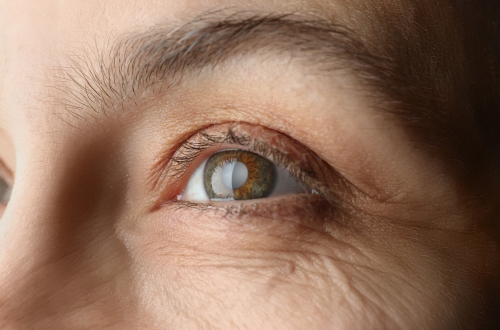The Link Between Diabetes and Eye Health: Understanding Diabetic Eye Disease
Diabetic eye disease encompasses a group of conditions in ophthalmology that affects patients with diabetes, often leading to potential blindness or moderate to severe visual impairment (MSVI) if left untreated. Diabetes is a chronic metabolic disease that impacts the ability to produce or respond to insulin, resulting in high blood sugar levels (i.e., hyperglycemia). Chronic hyperglycemia results in lasting damage that negatively impacts several aspects of health in the body, including eye health. Diabetic eye disease is not usually accompanied by clear warning symptoms, but early detection and treatment are known to reduce the risk of blindness in these patients by as much as 95%.
To recognize the importance of raising awareness about regular eye screenings and blood sugar control in individuals with diabetes, National Diabetes Month is observed every November. As we approach the start of this year’s campaign, TFS Ophthalmology Contract Research Organization (CRO) is joining the global effort to spread the word about how people with this chronic metabolic condition can protect their vision. This article will examine the significant connection between diabetes and eye health, discussing the various types of diabetic eye diseases, their impact, prevention strategies, and the importance of regular eye care for individuals with diabetes.
Continue reading to learn more about the crucial link between diabetes and vision impairment!
What is Diabetic Eye Disease?
With rising rates of obesity and increasing life expectancies, the International Diabetes Federation (IDF) estimates 700 million individuals will be living with diabetes by 2045. This significant increase in the global burden of diabetes will be accompanied with similar increasing prevalence rates of diabetic eye diseases. Long-term hyperglycemia can change fluid levels or cause swelling in the tissues of your eyes, resulting in blurred vision and lasting damage to the delicate blood vessels there. In more serious cases of diabetic eye disease, damaged blood vessels can leak fluid or bleed into the middle part of the eye, causing scarring or dangerously high intraocular (i.e., within the eye) pressure.
This group of diseases specifically encompasses conditions such as diabetic retinopathy, diabetic macular edema, cataracts, and glaucoma. There are three types of diabetes and individuals with any of them are at a higher risk of developing at least one diabetic eye disease: type 1 diabetes, type 2 diabetes, and gestational diabetes, which develops in some women during pregnancy.
Understanding Diabetic Retinopathy as a Secondary Comorbidity of Diabetes
Falling under the ophthalmology therapeutic area, diabetic retinopathy occurs when blood vessels in the retina swell, leak or close off completely. There can also be unusual growth of new blood vessels on the surface of the retina, the light-sensitive tissue at the back of the eye, further impairing vision.
In clinical practice, ophthalmology health care providers monitor diabetic retinopathy through its four stages of development.
- Mild non-proliferative retinopathy (NPR): High blood sugar causes small areas of balloon-like swelling in the retina’s blood vessels, called microaneurysms, to occur.
- Moderate NPR: As the disease progresses, some blood vessels in the retina become blocked. Common symptoms at this stage include a combination of microaneurysms, retinal hemorrhages (i.e., bleeding), vision spots, and other visual abnormalities.
- Severe NPR: The retina becomes more deprived of valuable nutrients as more blood vessels become damaged and blocked. To restore blood flow, the retina promotes neovascularization, the process of growing new blood vessels. Intraretinal hemorrhages are characteristic at this stage.
- Proliferative diabetic retinopathy (PDR): Neovascularization continuous, with new blood vessels abnormally growing in the retina and into the vitreous, the clear fluid that fills our eyes. These vessels are typically fragile and can leak blood, which leads to severe vision loss and blindness. Vitreous or preretinal hemorrhaging can occur at this stage.
Previous studies found that mild NPR occurred in 25% of diabetics within 5 years of diagnosis, 60% at 10 years, and 80% at 15 years. On the other hand, the incidence rate of PDR ranged from 2% of those who had diabetes for less than 5 years to 15.5% in patients who had been diagnosed 15 years ago or more.
Diabetic Macular Edema: A Serious Complication in Diabetics
Diabetic macular edema is a result of fluid building up on the retina, causing swelling and blurry vision, and eventually, permanent vision loss. The macula is the center of the retina and is responsible for providing sharp central vision; it has the highest concentration of rods and cones, which are photoreceptor cells that perceive light in our eyes. This type of diabetic eye disease is another leading cause of visual impairment in Americans. Each year, macular edema caused by diabetes affects over 75,000 individuals within the U.S., and nearly 100 million people worldwide.
Prolonged hyperglycemia caused by diabetes results in the build-up of substances called advanced glycation end products (AGEs), which can drive an osmotic flow of water across membranes to cause fluid retention within the eye. Diabetes also causes damage to the tight junctions in the blood-brain barrier (BBB), allowing large molecules such as proteins, lipids, and inflammatory substances to enter. These molecules then accumulate on the retina, promoting further inflammation, and later leads to visual impairment, scarring, and/or blindness.
The Impact of Diabetes on Cataract and Glaucoma Risk
Cataracts is an ocular disease in which the natural lens of the eye becomes cloudy, resulting in blurry, hazy, or less colorful vision. In people with diabetes, the chances of developing cataracts are twice as high as in other adults and is more likely to occur at a younger age. This cloudiness is exacerbated by swelling in the eye, also known as macular edema, which is a common complication of diabetes, especially in those with diabetic retinopathy. Typically, cataract surgery is required to restore vision in individuals with this diabetic eye disease. The procedure involves replacing the natural cloudy lens with a clear, artificial lens called an intraocular lens (IOL), but the choice of IOL is more limited in patients with diabetes.
Post-cataract surgery complications with various forms of glaucoma are also more common in individuals with diabetic eye disease. Glaucoma is a group of chronic eye conditions wherein swelling and fluid retention in the retina causes the intraocular pressure to become too high. Not only does diabetes double the risk of developing glaucoma, certain medications (e.g., steroid treatments) used for treating other diabetic eye diseases can increase this pressure as well. Diabetic glaucoma also increases the chances of having high intraocular pressure after cataract surgery.
The Importance of Regular Eye Screenings to Maintain Eye Health
Regular eye exams are a core part of maintaining overall eye health, but they also ensure serious conditions such as diabetic eye diseases can be detected and treated early. Ophthalmic disorders can usually go a long time without presenting any signs or symptoms, but if found too late, they can cause permanent irreversible damage to your vision.
Undergoing a comprehensive dilated eye exam by an ophthalmologist is the only way to detect diabetic eye diseases early and significantly reduce your risk of visual impairment or blindness in the future. In this non-invasive exam, the first step involves an assessment of vision problems, such as nearsightedness or farsightedness. Next, the physician will administer eye drops to dilate or widen your pupils, checking for signs of abnormal ocular responses.
The U.S. Preventive Services Task Force recommends regular eye exams be done at varying intervals in different patient populations to maintain proper long-term eye health:
- Children should have at least one eye exam between the age of 3 and 5 years.
- People with diabetes should have a dilated eye exam every year.
- Other high-risk individuals should have a dilated eye exam every 2 years:
- Black Americans 40 years and older
- All adults older than 60, especially Mexican American adults
- People with a family history of glaucoma
Five Key Strategies for Managing and Minimizing the Risk of Diabetic Eye Disease
Diabetes is a common risk factor for several other chronic conditions, including the ophthalmic disease we discussed here. To manage and minimize this risk, the American Academy of Ophthalmology (AAO) recommends five key preventative and management strategies in patients who have diabetes.
1. Get Regular Eye Exams
Visit your ophthalmologist for a comprehensive dilated eye exam at least once a year to monitor your eye health. Diabetic eye diseases often do not present with early warning signs, but during this exam, your physician can assess your retina and optic nerve for signs of damage before irreversible changes to your vision occur.
2. Control High Blood Sugar from Diabetes
Prolonged hyperglycemia from diabetes is damaging to blood vessels throughout the body, but especially in the delicate vessels within the eye. Adopting a balanced, nutritional diet and regularly monitoring your blood sugar levels with convenient at-home devices will help prevent hyperglycemia spikes. Talk to your healthcare provider about additional strategies for minimizing the risks of high blood sugar from diabetes.
3. Maintain Healthy Blood Pressure and Cholesterol Levels
Diabetes is commonly associated with high blood pressure and elevated cholesterol levels in the body, but practicing certain lifestyle behaviors and eating nutritional foods can be effective for managing these conditions. Your healthcare provider may also consider certain medications to decrease blood pressure or cholesterol levels and promote better eye health.
4. Quit Smoking or Do Not Start Smoking
Smoking negatively affects every organ in the body, but especially the eyes. Patients who have diabetes and are smokers have a higher risk of developing diabetic retinopathy and cataracts, among other non-diabetic eye diseases. Smoking cessation reduces your risk of these and other diseases right away. Consult with your healthcare provider for the right strategies that are best suited for you.
5 Exercise on a Regular Basis
Physical activity is one of the most effective strategies for helping manage obesity, diabetes, cardiovascular disease, and several other conditions. Collectively, exercising regularly indirectly helps protect your eye health by reducing blood pressure, cholesterol levels, and blood sugar levels. For example, the AAO suggests that consistently going for a walk three times a week long-term can lower your intraocular pressure and improve blood flow to the retina and optic nerve.
Conclusion
In conclusion, the link between diabetes and eye health in ophthalmology is multi-faceted and substantial, requiring a comprehensive approach to the early prevention, detection, and treatment of diabetic eye diseases. As we approach National Diabetes Month this November, this article aims to share greater awareness about the importance of regular eye screenings, strict blood sugar control, and other key strategies about managing diabetic eye diseases. These diseases are among the leading causes of high global rates of blindness and visual impairment in people with diabetes.
If you have diabetes, regularly visit your ophthalmologist and general practitioner to discuss key preventative steps that will ensure your vision is protected for years to come. This National Diabetes Month, we encourage readers to join the collaborative efforts of TFS Ophthalmology CRO, healthcare providers, and researchers to improve eye health and quality of life for those affected by diabetes.
For more information about how you can contribute, visit this page from the U.S. National Institute of Diabetes and Digestive and Kidney Diseases.
TFS HealthScience: Your CRO Partner in Ophthalmology
Experience the difference with TFS HealthScience Ophthalmology CRO for your ophthalmology clinical trials! With a global mindset and local understanding, we provide a comprehensive suite of services for your next study, including study protocol design, medical monitoring, and project delivery. Our experienced teams and innovative technology ensure efficient delivery, no matter the complexity. Trust TFS HealthScience to take your clinical trials to the next level with our dedicated Ophthalmology team.
Visit our website to learn more about the data-driven solutions we can offer for your next clinical trial or connect with a TFS representative here!
Interested in more ophthalmology clinical trials content from us? Visit the TFS Intellect Hub to access the latest articles, case studies, white papers, and more from our Ophthalmology CRO!
Connect with Us
Contact us today to discover how TFS can be your strategic CRO partner in clinical development.



